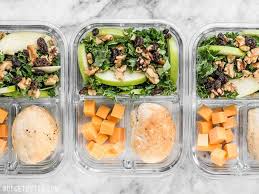Meal prepping is all about preparing meals or ingredients ahead of time so you can eat more efficiently—and often more healthfully—throughout the week. Because it requires planning, meal prep encourages better food choices and can help you stay on track with your nutrition goals.

It’s especially helpful for busy individuals, since having meals ready to go can save time, reduce stress, and minimize last-minute unhealthy eating. With prepared meals on hand, you’re less likely to resort to frozen dinners or fast food when you’re too tired to cook.
Contrary to popular belief, meal prepping doesn’t have to mean spending your entire Sunday in the kitchen. There are multiple methods to choose from, so you can tailor the approach to fit your routine.
Here’s a breakdown of the key principles and steps to help you get started with meal prep, even as a beginner.
Meal Prep Methods: Choose What Works for You
Meal prepping doesn’t require a full weekend commitment. In fact, there are several flexible strategies that cater to different needs and schedules.
Popular meal prep methods include:
-
Make-ahead meals: Entire meals cooked ahead of time and stored in the fridge for easy reheating, ideal for dinners.
-
Batch cooking: Preparing large quantities of a recipe, dividing it into portions, and freezing for later. Great for lunch or dinner staples.
-
Individually portioned meals: Freshly made meals divided into single-serve containers for convenient grab-and-go options, perfect for lunches.
-
Pre-prepped ingredients: Chopping, washing, or marinating ingredients ahead of time to cut down on cooking when you’re ready to make the meal.
You can stick to one method or mix and match based on your needs. For instance, make-ahead breakfasts might simplify your mornings, while frozen batch meals are great for busy evenings. Try out a few approaches to discover what suits your schedule best.
Planning Meals: Quantity and Variety
Knowing how many meals to prep and what to include can feel overwhelming at first, but a little planning makes all the difference.
Start by choosing which meals—breakfast, lunch, or dinner—you want to prep for. Then, look at your schedule to determine how many of each you’ll need. Be sure to account for days you’ll eat out or have special events planned.
Stick with familiar recipes at first to ease the process. As you get more comfortable, experiment with variety to avoid boredom and ensure you’re getting a range of nutrients. Aim for meals that include a mix of proteins, vegetables, and complex carbs like quinoa, brown rice, or sweet potatoes. Including a vegetarian dish or two can also add diversity.
Save Time with Smart Strategies
The goal of meal prepping is efficiency, not spending hours in the kitchen. These tips can help you prep smarter and faster:
Set a Weekly Routine
Create a consistent schedule for shopping and prepping. You might shop and cook on Sunday mornings or prepare weekday lunches on Monday nights. Consistency helps form a lasting habit and reduces decision fatigue.
Choose Complementary Recipes
Avoid backlogs in the kitchen by picking recipes that use different appliances. For example, don’t rely on the oven for every dish. A good combo might be one baked dish, a stovetop meal, and a no-cook option like a salad or sandwich.
Organize Cooking Workflow
Start cooking the dish with the longest cook time—such as soups or baked items—first. While those are on the stove or in the oven, you can prep other meals. Save cold dishes for last, and prep shared ingredients (like chopped onions) all at once.
Gadgets like rice cookers or slow cookers can also help reduce your hands-on cooking time.
Use a Grocery List
Shopping without a plan wastes time. Write a grocery list organized by store sections to avoid backtracking. Try limiting your trips to once a week and consider using a delivery service to save even more time.
Choose the Right Food Storage Containers
Your containers can influence how well your meals store and taste later. Here’s what to consider:
-
For ingredients: Use airtight, reusable containers like silicone bags or stainless steel to keep items fresh.
-
For reheating: BPA-free, microwave-safe containers such as Pyrex or silicone work well and are safer for your health.
-
For freezing: Look for containers that resist freezer burn—wide-mouth mason jars work well (leave space for expansion).
-
For transport: Leak-proof, divided containers (like bento boxes) are great for on-the-go meals or ones that should be assembled just before eating.
Stackable containers will also help maximize storage in your fridge or lunch bag.
Keep Food Safety in Mind
Safe storage and reheating is essential to avoid foodborne illness, which affects millions annually. Follow these food safety basics:
-
Maintain correct fridge and freezer temps: Keep your refrigerator at 40°F (5°C) or below, and your freezer at 0°F (-18°C).
-
Refrigerate quickly: Store cooked or fresh food within two hours of preparation. Spread food in shallow containers to cool quickly.
-
Know your storage limits: Cook fresh meat and poultry within 1–2 days, red meats within 3–5 days, and always store on the bottom shelf.
-
Cook food to safe temps: Meats should reach 165°F (75°C) internally.
-
Thaw safely: Use the fridge or cold water—not the counter—to defrost frozen food.
-
Reheat once: Reheat defrosted meals only once to minimize food safety risk.
-
Label everything: Mark containers with the prep date to keep track of freshness.
-
Eat within safe windows: Refrigerated meals should be eaten within 3–4 days, and frozen meals within 3–6 months.
Your Step-by-Step Meal Prep Plan
Feeling ready to dive in? Follow these simple steps to meal prep like a pro:
-
Pick your method: Choose (or combine) meal prep styles that suit your lifestyle and goals.
-
Set a consistent schedule: Designate one day a week to plan, shop, and cook.
-
Plan the number of meals: Consider your week’s events and determine how many meals you’ll need.
-
Select recipes: Choose a few familiar dishes and aim for variety and ease of preparation.
-
Simplify grocery shopping: Use a categorized list or order online.
-
Cook efficiently: Organize your cook times and use multiple methods to prep meals faster.
-
Store meals safely: Cool and label meals properly; refrigerate what you’ll eat soon and freeze the rest.
Final Thoughts
Meal prepping is a smart, time-saving strategy for anyone looking to simplify their week and eat healthier. Whether you cook entire meals, freeze batches, or simply prep ingredients, meal prepping can be tailored to fit your lifestyle and goals.
The key is to start small, stay consistent, and find what works best for you.


This guide was super helpful! I’ve always been overwhelmed by the idea of meal prepping, but breaking it down step by step made it feel so doable. Thank you!
Great tips!
I love how beginner-friendly this is. The grocery list suggestions were a game changer for me — finally feels manageable to eat healthy without spending hours in the kitchen.